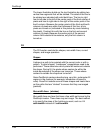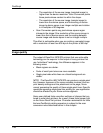
PostScript
Guide to Using Page Description Languages 1-31
File operators and standard devices
When “%stdin” is the filename for the
file
operator, DocuPrint
NPS/IPS does not create a new file object. For example, the
following PostScript segment uses %stdin to open a file from the
stdin device:
(%stdin) (r) file %
DocuPrint NPS/IPS returns the file object for %stdin created at
initialization time, which is used for reading the PostScript
master. Therefore, PostScript masters should avoid doing a
closefile
on %stdin because this action closes the file object that
is used by the PostScript interpreter to read the PostScript
master.
Although the use of the operator
file
on %stdin is common, other
PostScript operators such as
closefile
are rarely used with the
standard devices. Likewise, miscellaneous file operators such as
status
and
bytesavail
return different results when output is
compared among different implementations of PostScript, due to
differences in the implementation of file I/O.
Path limits
The LaserWriter has a limit of 1500 path segments that can be
defined in the current path. Any master that exceeds this limit
generates a limitcheck error.
DocuPrint NPS/IPS uses a different scheme for representing
paths in its internal memory than that used by the LaserWriter.
Although the maximum number of path segments is larger than
the LaserWriter’s (in other words, masters that print on the
LaserWriter also print on DocuPrint NPS/IPS without limitcheck
error), it is difficult to state the exact limit, due to the different
algorithm for storing rendered shapes in DocuPrint NPS/IPS.
PostScript VM limits
DocuPrint simulates PostScript virtual memory (VM) limits
(default=4 MBytes). When the PostScript VM limit is reached, it
sends the PostScript error message “VMe=Error” to the “JOB
AND ERROR MESSAGES” page. In rare cases when real VM
runs out, the printer controller sequencer is automatically
restarted and the job is held for either restart or cancellation by
the operator.


















